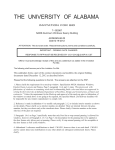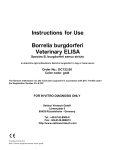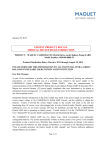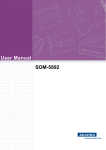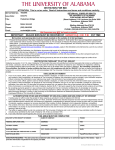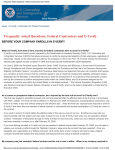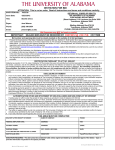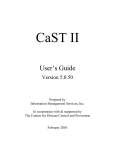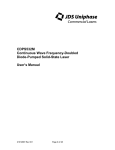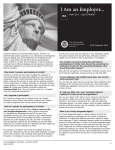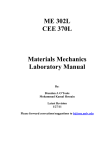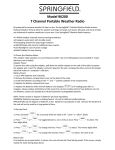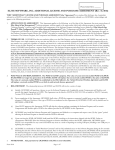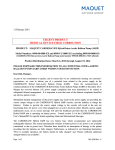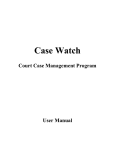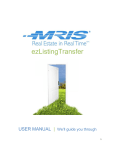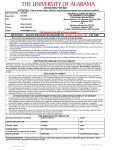Download The Mississippi Employment Protection Act
Transcript
The Mississippi Employment Protection Act By Mike Farrell1 Introduction. The Mississippi Legislature has stepped off into new territory by requiring employers to use the federal E-verify system. That system allows employers to determine if their new hires are lawfully in this country. Ironically, Mississippi is mandating that employers use a program that is voluntary under federal law. Less than a handful of other states (Arizona and Oklahoma) have a similar law. The governor of Minnesota has ordered state agencies (but not private employers) to use the system. These laws are an obvious reaction to the federal government’s inaction on the immigration issue. Illinois has gone the other way by prohibiting employers from using the e-verify system. What the heck is E-verify? E-verify is an online system to electronically verify the eligibility of newly hired employees. An early version of the system was implemented by the Department of Homeland Security (DHS) and the Social Security Administration (SSA) about 10 years ago. Since it is voluntary, participation nationally has been relatively low. That is about to change in Mississippi. All employers are currently required by federal law to complete an I-9 form when hiring new employees. That form requires employers to visually inspect (but not keep) certain identification documents, e.g., passports, green cards, driver’s licenses, Military ID cards, birth certificates and similar information. The I-9 form is typically filed away and forgotten about until the SSA sends a no-match letter. Then the employer must advise the employee to contact the SSA. The employees have up to 90 days in some cases to contact the SSA about the mismatch. By that time, they may have been employed for many months. The E-verify system operates at warped speed compared to that process. Within three days of a hire, participating employers are required to check the identifying information on the I9 forms with the E-verify system. Within seconds of submitting its information, the employer 1 Mike Farrell practices in all aspects of employment law and business litigation. He is a graduate of Mississippi State University and Georgetown University Law Center. will receive an “employment authorized response” if all goes well. Otherwise, the employer will receive a “SSA tentative non-confirmation” response if either SSA or DHS was able to confirm the employee’s personal information. The employer must then advise the employee of his or her right to contest the response by personally visiting a SSA office within 8 or 10 working days (depending on which government publication you read). During that time the employer is prohibited from terminating the employee. If the employee does not contest the response, he or she may be terminated. Memorandum of Understanding. Like most federal voluntary programs, there are strings attached. As a part of registering for the e-verify system, employers enter into a Memorandum of Understanding (MOU) with the SSA and DHS. They voluntarily agree to do some thing that are not required by federal law. For starters, they subject themselves to fines of up to $1,000 for failing to terminate an employee who has not been confirmed by the E-verify system. That civil fine is in addition to criminal penalties under federal law for knowingly employing an illegal alien. There are other changes. The employer agrees to accept only documents that have a photograph for I-9 purposes. The employer also agrees to make and keep a copy of the photos and the other documents with the I-9 form. In addition to getting faster, the program is improving its technology. Last fall, the program added a Photo Screening Tool that is the beginning of a biometric verification system. That system allows employers to compare the photo of new hires, employment authorization documents or green card against the 14.8 million images stored in DHS immigration databases. The program is designed to detect a bogus photo on an authentic identification card. Employers can E-verify selective new hires. The MOU specifies that if an employer uses the E-verify system for one employee, it must use it for all. Therefore, an employer using the Everify for new hires in Mississippi would also have to use the system for its new hires nationwide. The legislature may not have intended that result. This E-verify system requires a company representative to take a tutorial and become familiar with the 63-page user manual. The bottom line is that E-verify is another federal bureaucracy and another set of federal regulations. The future of the law in its present form is still an open question. Immigrant Rights groups have promised a court fight. Some business groups would like to seek some tweaking of some aspects of the new law. When Governor Barbour signed the bill, he said employers should be limited to E-verify as the only way to verify new hires. Since the legislature has adjourned for this year, there will be no amendments this year in the absence of a special session. Overview of the Mississippi Law. The Act phases in over three years depending on the size of the employer. Once an employer becomes covered, the statute applies prospectively to new hires only. Existing employees do not have to be verified. There are no criminal penalties for employers. However, an illegal alien is subject to a felony conviction, prison time of 1-5 years and a fine of up to $10,000 or both. Employers are subject to civil penalties including the loss of a license to conduct business in the state, the loss of any state contracts, and being debarred from future state contracts for three years. Responsibility for enforcement is fractured among five state agencies - the Mississippi Department of Employment Security, the State Tax Commission, Secretary of State, Department of Human Services and the Attorney General. The statute says that all those agencies shall have the authority to “bring charges” and “seek penalties.” The statute does not specify whether those agencies can administratively impose the civil penalties or whether it must seek a court order. The following is a summary of some of the key provisions with citations. Link below to a full text of the new act. Registration Requirements. Every employer shall register and use the federal E-verify program. § 2(4)(b)(i). No contractor or subcontractor shall hire any employee without first registering and participating in the E-verify program. § 2(4)(b)(ii). Contractors and subcontractor getting a state contract after 7-1-08 shall register and participate in the e-verify system. § 2(4)(b)(iii). Third-party employers (employment agencies) shall register with the MDES before placing employees in the work force, and provide proof to their customers of registration and participation in the e-verify system. §2(6). Effective Dates. State agencies, public contractors and subcontractors and private employers shall meet verification requirements by the following dates depending on size: § 2(7). Employees Date 250 or more 100 - 249 30 - 99 1 - 29 7-1-08 7-1-09 7-1-10 7-1-11 The Act is effective 7-1-08 for state agencies and employers with public contracts and all third-party employers. The Act becomes effective on 1-1-09 for all other employers. § 3. Administrative Penalties. Employers violating this section can (1) be subject to cancellation of any public contract, (2) be barred from public contracts for up to three years, (3) lose for up to one year any state license, permit, certificate or other document relating to the right to do business. § 2(7)(e). Criminal Penalties. It is a felony for a person to accept or perform employment knowing that he or she is unauthorized or an illegal alien. The penalty is one to five years in prison and a fine of $1,000 to $10,000 or both. § 2(8)(c). Appeals. An employer can appeal any penalty “to the appropriate entity bringing charges” or to the circuit court. § 2(7)(e)(iii). Enforcement Agencies. MDES, State Tax Commission, Secretary of State, DHS and the AG can “seek penalties and bring charges” for non-compliance. § 2(7)(f). Safe Harbor Provisions. An employer who is enrolled and uses the e-verify system shall be exempt from liability, investigation or suit. § 2(4)(e). A compliant employer shall be held harmless by MDES provided it does not participate in creating fraudulent documents and does not knowingly or willfully accept false documents. § 2(8)(a)(i). An employer is not liable if it hires an illegal alien through a state or federal work program requiring E-verify system. § 2(5). Any applicant for employment has no liability if he or she has been referred by MDES and if MDES has verified the applicant’s lawful presence. § 2(8)(a)(ii). Individual homeowners who hire workers on their private property for non-commercial purposes. § 2(8)(a)(iii).




